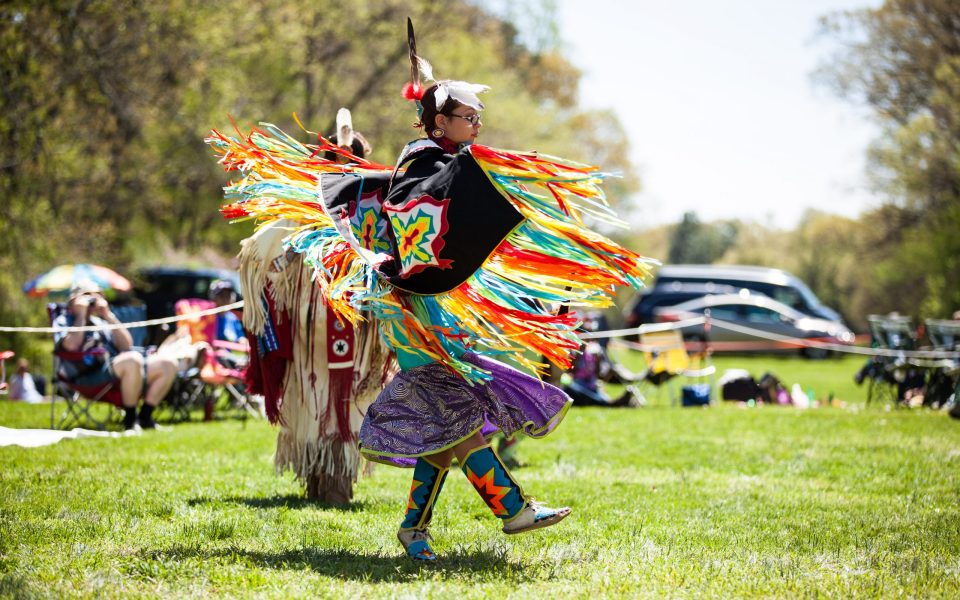by Sayaka Matsuoka/ photos by Caleb Smallwood
The four men sat in a circle, pounding on the circular drum in front of them with strong, swift motions. They chanted loudly into microphones that carried their voices over the lawn, merging with the sound of bells jingling from dancers’ garments just a few yards away.
The annual free community day at the Reynolda House in Winston-Salem took the form of a pow wow on a bright and cloudless day on April 11, bringing together people of Native American and other backgrounds. While pow wows are generally competitive events that take place between different tribes, allowing each to showcase their drummers and dancers, this smaller event occurred in conjunction with the museum’s ongoing traveling exhibit George Catlin’s American Buffalo, which will be on display for a few more weeks.
Vendors lined the lawn, selling handcrafted jewelry, garments, blankets and instruments like beautifully carved wooden flutes. Inspired by the traditions of several tribes, many of the crafts are considered pan-Indian while others ascribe to specific heritages such as the delicate Navajo horsehair ornaments that hung from one tent. Several of the artists wore the traditional garb of their tribes, including a woman adorned in an intricate and geometric Lumbee dress.
“The dress is quilted with a design based on the pinecones that are abundant in the South,” she said.
Originating in what is now North Carolina, the Lumbee tribe boasts approximately 55,000 members — 2,000 of them in the Triad area — making it the largest tribe in the state.
Rick Oxendine, the director of the Guilford Native American Association who is also Lumbee, expressed his excitement at the pow wow’s success.
“We’ve had such an amazing response from the non-Native American community,” Oxendine said. “People love to learn about the food, dancing and arts and crafts.”
As the dancers entered the circular roped enclosure, audience members crowded around to spectate while several others hopped in line to join the procession. The Native-American dancers led the Two-Steppers Dance, holding hands and swaying to the beat of the music while the participants followed suit, mirroring their movements. Several different styles of dance ensued over the course of the afternoon like the Two-Steppers dance and the Southern Straight Dance, aka the Gentleman’s Dance. Although each was distinctly different with varying steps set to specific music, all of those involved wore colorful regalia, complete with kingly feathers and fringe decoration. Many also wore bells that rang with each rhythmic step.
Bells even covered one woman’s dress from head to toe. She explained that hers was an Ojibwe dress and that the sound of the bells was meant to represent healing and rain.
Artifacts from the Museum of Anthropology at Wake Forest adorned a table showcasing the history of different tribes while mini-craft stations allowed children to make their own Native American bracelets, clay pots or shields. A storyteller captivated attendees with colorful yarns that have been told by tribes for centuries.
Phil Archer, the director of public programs for the Reynolda House, elaborated on the importance of this type of all-inclusive event.
“Art tells stories about the artist or subjects,” Archer said. “We learn from art and find meaning in ourselves and in the past.”
While the pow wow was conceived as a companion to the ongoing exhibition, the event, in a way, became its own work of art, engaging and educating individuals through Native American culture.
Join the First Amendment Society, a membership that goes directly to funding TCB‘s newsroom.
We believe that reporting can save the world.
The TCB First Amendment Society recognizes the vital role of a free, unfettered press with a bundling of local experiences designed to build community, and unique engagements with our newsroom that will help you understand, and shape, local journalism’s critical role in uplifting the people in our cities.
All revenue goes directly into the newsroom as reporters’ salaries and freelance commissions.


Leave a Reply